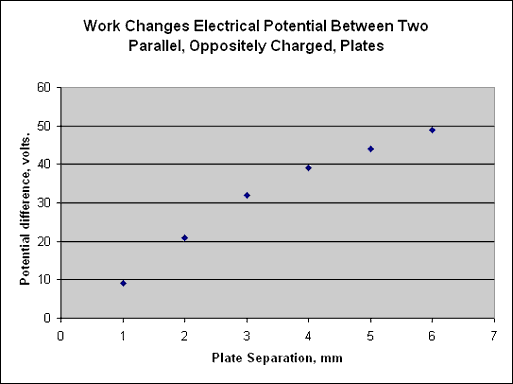Experiment of The Month
A Volt is a Joule per Coulomb

The measuring device is our best voltmeter. The device, called an electrometer, has very high input impedance so that it draws practically no current while measuring a potential difference up to 100 volts. At 1014 Ohms, it is at least a million times better than typical voltmeters. In the photograph, the electrometers
Thin plastic sheets in the gap between the plates ensure that they never touch. A
The electric field between the two oppositely charged plates is mostly vertical and mostly uniform. We follow tradition and take it to be uniform and vertical. Staying with this simple model, we take the electric field due to the upper plate to be uniform and vertical. The charge on the lower plate experiences an upward force due to the field of the lower plate.
In the demonstration, the battery is removed after moves charge from bottom to top and
If the position of the lower plate is changed, the electric force on it does work. The amount of work done by the electric field has the same magnitude as the change in electrical potential energy of the system. With uniform electric field, the work
As usual, it is up to us to choose the situation which has zero potential energy. It is natural to identify zero potential energy with zero separation between the plates. Then the electrical potential energy is proportional to the separation of the plates.
Now it is time to recall the formal definition of electrical potential as electrical potential energy per unit charge. Since in this demonstration the battery is removed after establishing the 9V potential difference between the plates, the charge on each plate remains constant. As a result, the electrical potential energy is simply proportional to the electric potential (the "voltage").
Following this reasoning, the reading on the voltmeter should be proportional to the separation of the plates. To test this assertion, we start with a narrow gap, at 9V, and lower the bottom plate by lowering the laboratory jack, while measuring the potential difference between the plates. In this demonstration, the electrometer is set to measure 100 volts, full scale.
We made a video recording of the demonstration. A sequence of stills from a second run of the demonstration is shown below.
| Gap is 1mm, potential difference 9V |
 |
| Gap is 2mm, potential difference 21V |
 |
| Gap is 3mm, potential difference 32V |
 |
| Gap is 4mm, potential difference 39V |
 |
| Gap is 5mm, potential difference 44V |
 |
| Gap is 6mm, potential difference 49V |
 |
A graph of potential versus plate separation shows agreement with expectations for small separation. (The first three data points fall on a nice straight line.)

At large separation, the approximation that the field is uniform begins to fail. (It only works for plates which are "large" compared to the size of the gap between them.) For very large separations, we expect the field to fall in accordance with Coulomb's law. This means that for large separations, less work is done to pull the plates apart. In turn, the change in potential energy and in the potential is smaller as we move through larger separations.
A second reason for the "fall off" in the graph at high potential is our relatively high humidity. This leads to flow of charge through the air when potential differences become large. It takes only a minute for the potential to fall by half under the conditions of this demonstration.
-
Contact Information
Contact Number: 717-871-4297
Email: physics@millersville.edu